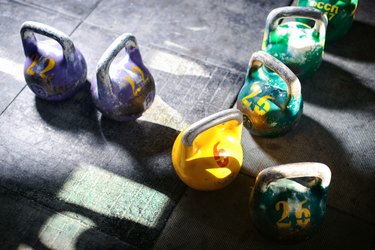
Maybe you have a major event coming up in two weeks that you want to look great for. Unfortunately, you're not quite where you want to be weight-wise. So how do you lose weight fast in just 14 days?
While there's no magic potion for dropping pounds ASAP, successful, long-term weight loss comes down to one simple thing: a caloric deficit. Essentially, that means burning more calories than you take in. You can do that through cutting calories from your diet or exercising more, or a combination of both.
Video of the Day
Video of the Day
Because you're facing a tight deadline, you may think that crash dieting and spending hours a day at the gym will help you create an even bigger deficit and thus lose more weight. And while that may be true in the short-term, it can result in regaining the weight you lost (and then some). It can also be detrimental to your future weight-loss efforts and overall health.
Take the smarter approach by following these six steps.
1. Set a Realistic Goal
Having a goal weight in mind makes it easier to stay focused and on track in the next two weeks. Even if you have a bigger overall weight-loss goal (say, 20 pounds or more), a good guideline is to aim to lose 1 to 2 pounds a week, according to the Mayo Clinic.
Four pounds in two weeks will take discipline and commitment, but it's an achievable goal. Anything more than that is unrealistic and unhealthy.
2. Do a Bit of Calorie Math
To create a calorie deficit, you need to figure out your total daily energy expenditure (TDEE), or the amount of calories you burn a day. And to get this number, you'll first calculate your basal metabolic rate (BMR), the rate at which your body naturally burns calories without any added activity.
According to the American Council on Exercise, the formulas are as follows for people assigned male at birth (AMAB) and people assigned female at birth (AFAB):
- For people AMAB:
9.99 x (weight in kg) + 6.25 x (height in cm) – 4.92 x (age in years) + 5
- For people AFAB:
9.99 x (weight in kg) + 6.25 x (height in cm) – 4.92 x (age in years) – 161
(Keep in mind that calorie needs depend on much more than assigned-sex-at-birth, including genetics, metabolism, level of physical activity and underlying health conditions. Everyone's calorie needs are different.)
To get your TDEE, multiply by an activity factor:
- Sedentary (little to no exercise): 1.2
- Lightly active (exercising one to three days per week): 1.375
- Moderately active (exercising six or seven days a week): 1.55
- Very active (exercising every day and sometimes twice a day): 1.725
Once you have your TDEE, subtract 250 to 500 calories to get your recommended daily caloric intake for weight loss.
Or, to avoid having to crunch all these numbers yourself, use a calorie-tracking app, which will calculate your caloric need based on things like your current weight, activity level and weight-loss goal.
3. Track Calories and Macros
Now that you have your daily calorie goal, you have to stick to it in order to reach your weight-loss goal. Write down everything you eat each day or record it in an app.
Make sure you're eating a healthy balance of macronutrients (aka macros), too. These include carbohydrates, protein and fat.
A typical macro ratio is 40 percent carbs, 30 percent protein and 30 percent fat. You can get your carbs from fresh fruits and vegetables and whole grains. Protein should come from lean poultry or fish (or vegetarian sources like beans and tofu). And get your healthy fats from sources like olive oil and avocados.
4. Be Strategic About Meals
How many meals you eat a day depends on your preference and schedule. But many people find that eating five or six small meals a day helps to keep their appetite under control and prevent any overeating at meals. Start your day with breakfast followed by a mid-morning snack, lunch, mid-afternoon snack and dinner.
Alternatively, some people find a strategy with fewer meals works better for them. This could be either three larger meals (breakfast, lunch, dinner) or narrowing your eating window with intermittent fasting (for example, only eating between the hours of noon and 8 p.m.).
5. Drink More Water
Dehydration can actually cause your body to retain water, which can make you look bloated. And because thirst can often be confused for hunger, drinking water throughout the day or before a meal can help you avoid overeating or mindless snacking.
The general guideline you may have heard is eight 8-ounce glasses of water a day. The National Academies of Sciences, Engineering and Medicine recommends getting anywhere from 11.5 to 15.5 cups of water per day, through drinking or water-rich foods.
This should mostly come from water, but it can also come from the foods you eat (especially fruits and vegetables) and other beverages. (Just keep in mind that some other beverages have calories.)
6. Get Moving
The other side of the equation is burning calories, which means being more active. The American College of Sports Medicine recommends that an adult should be doing at least 150 minutes of physical activity a week — about 30 minutes a day for five out of the seven. Here are some ideas to get you going:
- Go for a 30-minute jog or walk first thing in the morning to set a balanced tone for the day.
- Ride your bike to and from work or while doing a few easy errands.
- Take frequent breaks at work for a quick 5- to 10-minute walk.
- Incorporate strength training, which helps increase muscle mass and boost your metabolism.
- Do a few high-intensity interval training (HIIT) workouts each week to help bolster your daily caloric burn in less time.
A Note on Sustainable Weight Loss
When your goal is to lose weight in two weeks, you might be tempted to try a crash diet, cleanse or "detox" that promises fast weight loss. And while these may cause the scale to move quickly, the effects will be only temporary, and you're likely to regain any weight you've lost, and then some.
A helpful rate of weight loss is 1 to 2 pounds per week, per the Mayo Clinic, and dropping pounds at a faster rate than that could slow down your metabolism and lead to nutritional deficiencies as well as gallstones. It also makes you more likely to regain the weight.
To lose weight and keep it off, focus on eating a nutritious, balanced diet and pursuing an active lifestyle, exercising to the extent that you're able on a regular basis.
- The National Academies of Sciences, Engineering and Medicine: Dietary Reference Intakes for Electrolytes And Water
- American College of Sports Medicine: The Science of Exercise
- Mayo Clinic: Weight loss: 6 strategies for success
- American Council on Exercise: Resting Metabolic Rate: Best Ways to Measure It—And Raise It, Too
- American Council on Exercise: 7 Things to Know About Excess Post-exercise Oxygen Consumption (EPOC)
- Adipocyte: Increasing muscle mass to improve metabolism


